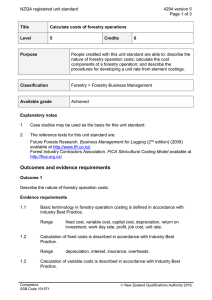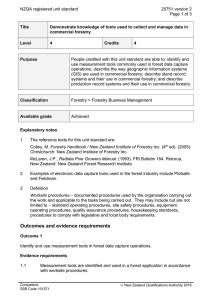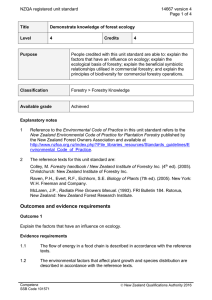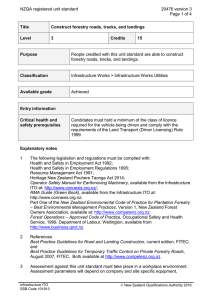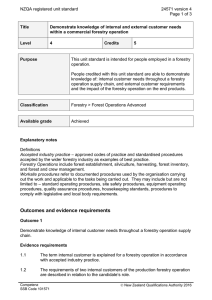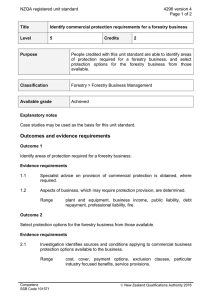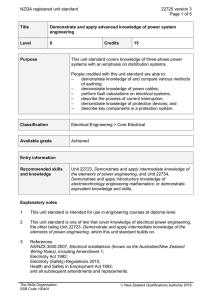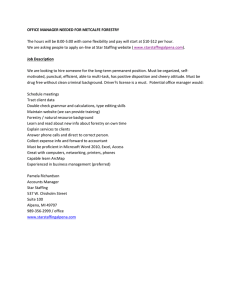NZQA registered unit standard 1137 version 5 Page 1 of 4
advertisement
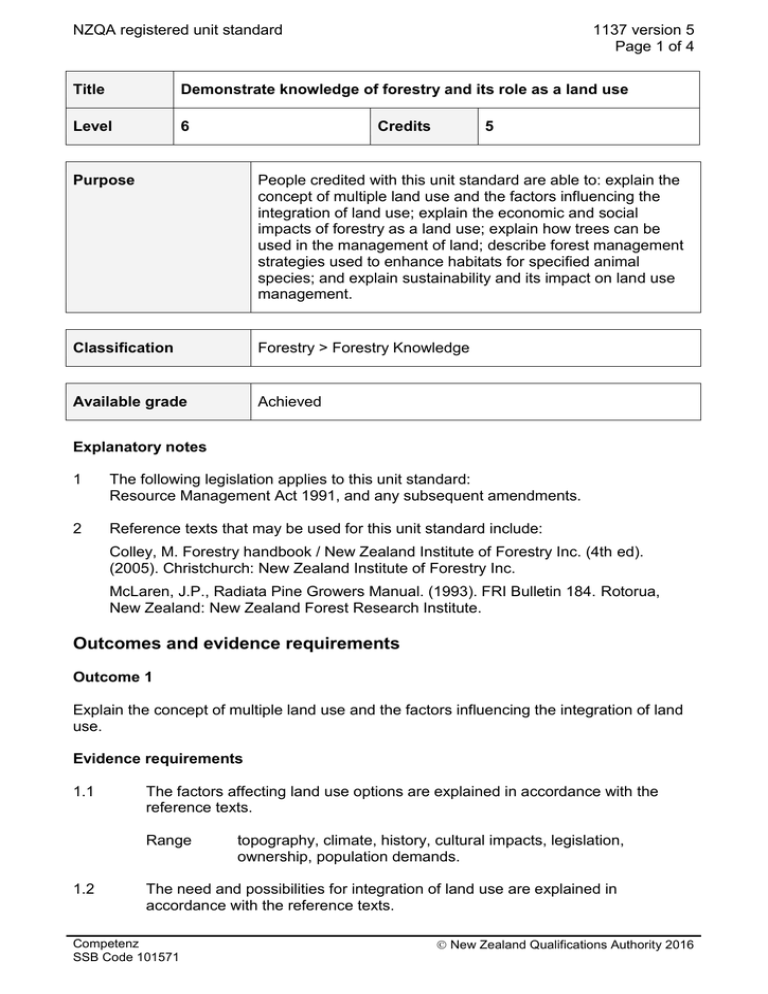
NZQA registered unit standard 1137 version 5 Page 1 of 4 Title Demonstrate knowledge of forestry and its role as a land use Level 6 Credits 5 Purpose People credited with this unit standard are able to: explain the concept of multiple land use and the factors influencing the integration of land use; explain the economic and social impacts of forestry as a land use; explain how trees can be used in the management of land; describe forest management strategies used to enhance habitats for specified animal species; and explain sustainability and its impact on land use management. Classification Forestry > Forestry Knowledge Available grade Achieved Explanatory notes 1 The following legislation applies to this unit standard: Resource Management Act 1991, and any subsequent amendments. 2 Reference texts that may be used for this unit standard include: Colley, M. Forestry handbook / New Zealand Institute of Forestry Inc. (4th ed). (2005). Christchurch: New Zealand Institute of Forestry Inc. McLaren, J.P., Radiata Pine Growers Manual. (1993). FRI Bulletin 184. Rotorua, New Zealand: New Zealand Forest Research Institute. Outcomes and evidence requirements Outcome 1 Explain the concept of multiple land use and the factors influencing the integration of land use. Evidence requirements 1.1 The factors affecting land use options are explained in accordance with the reference texts. Range 1.2 topography, climate, history, cultural impacts, legislation, ownership, population demands. The need and possibilities for integration of land use are explained in accordance with the reference texts. Competenz SSB Code 101571 New Zealand Qualifications Authority 2016 NZQA registered unit standard 1.3 1137 version 5 Page 2 of 4 The potential conflicts of different land uses with production forestry are explained in accordance with the reference texts. Range recreational, cultural, scientific, aesthetic, water supply. 1.4 The term land productivity is explained in terms of multiple uses in accordance with the reference texts. 1.5 The changes that occur during the life cycle of a forest and the impact these have on multiple land use management are explained in terms of pasture growth and stock numbers. Outcome 2 Explain the economic and social impacts of forestry as a land use. Evidence requirements 2.1 The economic and social impact of forestry as a land use is explained in terms of employment and effect on the community. Range employment opportunities, support industries, interaction with the community. 2.2 The impact of changing volumes of wood harvest on regional economies and communities is explained in terms of regional development and employment. 2.3 Forest product processing demands for land, water, energy, ports, and labour are explained in accordance with the reference texts. Outcome 3 Explain how trees can be used in the management of land. Evidence requirements 3.1 The use of forestry to manage and/or reduce erosion is explained in accordance with the reference texts. 3.2 The use of forestry to manage and/or reduce pest and weed problems is explained in accordance with the reference texts. 3.3 The use of forestry to stabilise sand dunes is explained in accordance with the reference texts. 3.4 The use of forestry in land restoration is explained in accordance with the reference texts. 3.5 The use of forestry in effluent disposal is explained in accordance with the reference texts. Competenz SSB Code 101571 New Zealand Qualifications Authority 2016 NZQA registered unit standard 3.6 1137 version 5 Page 3 of 4 The use of trees and forests for shelter, screening, and aesthetic purposes is explained in accordance with the reference texts. Outcome 4 Describe forest management strategies used to enhance habitats for specified animal species. Range endangered species – kiwi, kōkako; game species – deer, birds, trout. Evidence requirements 4.1 Management strategies used to enhance habitats for endangered species and game species are described in accordance with the reference texts. Outcome 5 Explain sustainability and its impact on land use management. Evidence requirements 5.1 The concept of sustainability is explained in accordance with the Resource Management Act 1991. 5.2 The impact of sustainability on forestry management practices is explained in accordance with the reference texts. 5.3 The contribution forestry makes to long-term sustainability in terms of overall land use is explained in accordance with the reference texts. Planned review date 31 December 2020 Status information and last date for assessment for superseded versions Process Version Date Last Date for Assessment Registration 1 28 January 1995 N/A Review 2 27 May 1998 N/A Review 3 27 May 2002 N/A Review 4 16 October 2009 31 December 2017 Review 5 10 December 2015 N/A Consent and Moderation Requirements (CMR) reference 0173 This CMR can be accessed at http://www.nzqa.govt.nz/framework/search/index.do. Competenz SSB Code 101571 New Zealand Qualifications Authority 2016 NZQA registered unit standard 1137 version 5 Page 4 of 4 Please note Providers must be granted consent to assess against standards (accredited) by NZQA, before they can report credits from assessment against unit standards or deliver courses of study leading to that assessment. Industry Training Organisations must be granted consent to assess against standards by NZQA before they can register credits from assessment against unit standards. Providers and Industry Training Organisations, which have been granted consent and which are assessing against unit standards must engage with the moderation system that applies to those standards. Requirements for consent to assess and an outline of the moderation system that applies to this standard are outlined in the Consent and Moderation Requirements (CMR). The CMR also includes useful information about special requirements for organisations wishing to develop education and training programmes, such as minimum qualifications for tutors and assessors, and special resource requirements. Comments on this unit standard Please contact Competenz at qualifications@competenz.org.nz if you wish to suggest changes to the content of this unit standard. Competenz SSB Code 101571 New Zealand Qualifications Authority 2016
